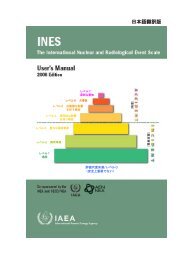Guidelines for Iodine Prophylaxis following Nuclear Accidents
Iodine_Prophylaxis_guide
Iodine_Prophylaxis_guide
You also want an ePaper? Increase the reach of your titles
YUMPU automatically turns print PDFs into web optimized ePapers that Google loves.
<strong>Guidelines</strong> <strong>for</strong> iodine prophylaxis <strong>following</strong> nuclear accidents1999 updatePrefaceIn 1989, the WHO Regional Office <strong>for</strong> Europe published <strong>Guidelines</strong> <strong>for</strong>iodine prophylaxis <strong>following</strong> nuclear accidents, primarily stimulated bythe Chernobyl accident. This was, however, prior to the significantincrease in cases of childhood thyroid cancer, first reported in Belarusin 1991 and verified by a mission from the Regional Office in 1992.The geographical extent of ground contamination by 131 I <strong>following</strong> theChernobyl accident had not been anticipated and, due to its relativelyshort half-life, was not fully realized even in 1989. Now it is clear thata population of roughly 2.3 million children living in southernBelarus, northern Ukraine and the most easterly regions of the RussianFederation was exposed to significant amounts of radioactive iodine.The result, less than fifteen years after the accident, is more than 1000cases of thyroid cancer, most probably solely attributable to this singlerelease of radioactivity to the environment.The decision to recommend the wide administration of stable iodinehas to be taken only when there is certainty that more good will beachieved than harm. In this respect the experience of Poland, inemploying stable iodine prophylaxis on a large scale (17 million dosesdistributed, 10 million to children) and evaluating the side effects, hasbeen crucial in the decision to issue these <strong>Guidelines</strong>.These <strong>Guidelines</strong> are based on a consultation with a wide range ofexperts in the relevant disciplines and are endorsed by three out of thefour regional thyroid associations.The sensitivity of the child’s thyroid to the carcinogenic effects ofradiation represents a significant public health risk in the event ofexposure to radioactive iodine. With effective planning and the use ofstable iodine prophylaxis, in association with other preventivemeasures, this risk is to a large degree avoidable.Dr Richard HelmerDirectorProtection of the Human EnvironmentSustainable Development and Healthy EnvironmentsWHO Headquartersi






